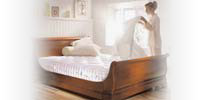1. Use a washable, protective cover to protect the mattress (and pillows) from stains. Barrier fabrics for allergy sufferers are also available.
2. In the mornings, throw back the bed clothes and leave the mattress to air for 20 minutes to allow body moisture to evaporate.

3. Turning your mattress over from side to side and end-to-end every few months (every week for the first three months) helps upholstery fillings to settle down more evenly. Some more luxurious mattresses, with much thicker layers of fillings designed to mould themselves to the contours of your body, may retain signs of these impressions, despite turning.
4. Don’t make a habit of sitting on the edge of the mattress and don’t let the kids bounce on it.
5. Don’t roll up or squash a mattress to store or transport it - this can cause permanent damage.
6. Handles are designed to help you position a mattress on its base - do not use them to support the full weight of the mattress - they may pull out and damage the fabric.
7. Don’t leave polythene wrappings on a new mattress - dampness mildew and rotting could all result from a build-up of condensation.
8. Vacuum your mattress and from time to time to remove fluff and dust. This should be carefully done so as not to dislodge fillings or damage tufts. Open windows while vacuuming - especially if there is an asthma sufferer in the house.
9. When tackling stains, use mild detergent and warm or cold water. Never over soak a mattress or base.
10. Putting a new mattress on a base for which it was not intended, a new mattress on an old base or board between the mattress and base can impede comfort and reduce the useful life of the mattress - as well as affecting any guarantees or warranties.
|